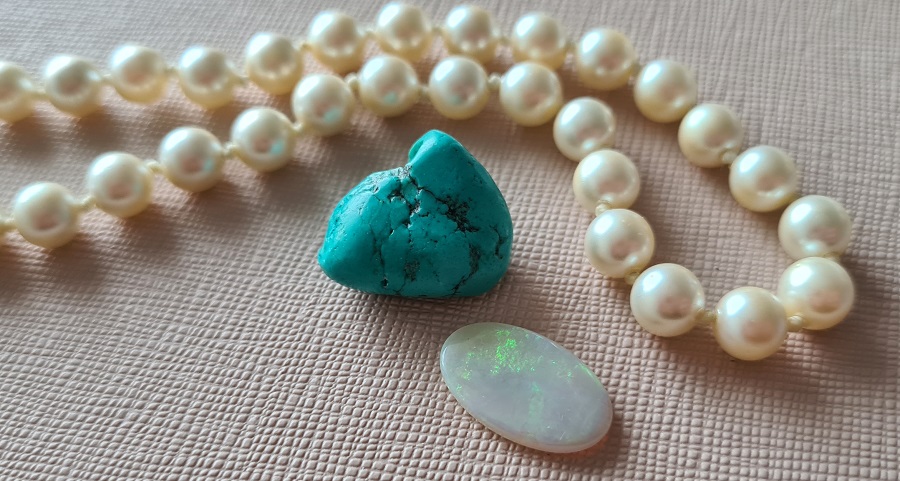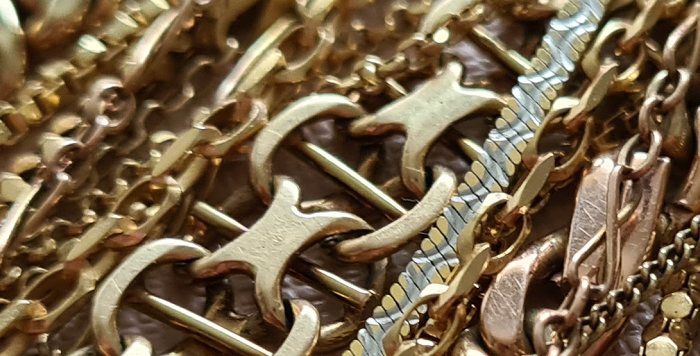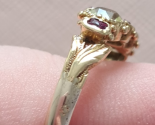
Frail materials: Pearls, turquoise and opals
Not all natural materials are created equal, and some, while stunningly beautiful, are more temperamental than others. The unholy trinity in this respect is, I believe, pearls, turquoise and opal, and they are as difficult in old pieces of jewellery as they are in new. In this article, we’ll take a look at each of them, why they are difficult to deal with and how best to handle them.
Pearls
Pearls, whether natural or cultured, are made up of a core, usually a grain of sand in natural pearls, covered in layers upon layers of nacre – the pearlescent material produced by and covering the inside of oysters. Pearls are an organic material and not a gemstone, and they are susceptible to both chemical and mechanical damage. In the chemical department, we have soaps, lotions, and perfume that may react negatively with the pearl and break down the layers of nacre over time. The result will be a pearl that loses its lustre and becomes dull or discoloured. In the mechanical department, the greatest threat is knocking the pearl into a hard surface, causing the pearl to crack. In both cases, it will usually be possible to replace the damaged pearl, but matching both the colour and the lustre of the other pearls may be difficult, and of course, the value may be reduced due to the repair.
Due to the frailty of the material, care should be taken when wearing pearls. Don’t sleep, shower or swim with pearls on, and put on your pearls last – after you’ve secured your ‘do with hairspray and after you’ve put on your favourite perfume. If possible, remove your rings before you wash your hands, and be mindful of your hands when wearing pearl-set rings.
Turquoise
Turquoise is a quite soft mineral, and it’s considered a semi-precious stone. It was immensely popular in Britain in the Georgian and Victorian Eras, both alone and combined with other gemstones, but as is quite obvious from a large portion of antique turquoise jewellery available on the market today, it doesn’t always age well.
Just like pearls, turquoise isn’t too fond of being exposed to the lotions and sprays that we tend to surround ourselves with, and when exposed to grease the beautiful turquoise colour may turn into a greenish shade that is way less appealing, perhaps especially when the colour change only applies to some of the stones in a multi-stone piece of jewellery. Some of the stones changing colour may stem from them being touched the most (either by being in constant contact with skin, or being most likely to be touched when the piece is handled, but there may be other reasons for the unevenness too: It may be due to the inherent quality of the material, “improvements” made to the stones pre-setting (i.e. inferior stones having been subjected to some form of treatment to make them look better) or some of the stones being fake. Gemstone sellers adding some fake material to a batch is certainly not unheard of, and when dealing with a piece of jewellery set with a large amount of stones, like turquoises and garnets, you may very well get some paste or plastic in-between the real stones. It is of course also possible that a former owner may have had a damaged stone replaced with a fake one – or one that has been treated, and which therefore holds colour differently from the original ones. Needless to say, a plastic “turquoise” will not age or react to external stimuli the same way a natural one will.
Rings are most prone to damage, but be mindful about when you put on your turquoise jewellery regardless.
Opals
Opals are truly stunning, but they are unfortunately also temperamental. Due to them being relatively soft, they scratch and crack fairly easily, and they’re also very sensitive to strong or abrasive chemicals, as well as oils. In addition you have to consider the water content of the opal; if exposed to heat or very dry air (the latter over time), it may dry out and crack.
Should I avoid these materials?
Personally, I don’t mind wearing any of these materials, but I think it’s wise to consider how one wears jewellery before making an investment. If you are prone to forget that you’re wearing rings or if you are really good at bumping into things, a ring set with such tender beauties may not be for you. Similarly, I’d avoid getting a ring I’d be wearing daily in any of these materials. They’re far more likely to stay beautiful if worn occasionally, rather than constantly. I’d be similarly careful about bracelets and bangles, as they too tend to get their fair share of bumps, but for any other pieces of jewellery, like necklaces and earrings, I wouldn’t worry – just remember that jewellery should be the last thing you put on – after your signature scent.







-
-
3 years
Tagged gold